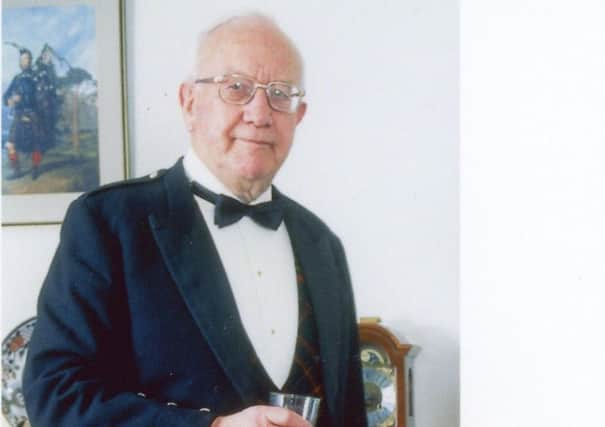Obituary: Lt Col David Murray, soldier and piper


Lieutenant Colonel David Murray was the last surviving officer of the Queen’s Own Cameron Highlanders to have fought at the Battle of Kohima, which in the spring of 1944 stopped the Japanese invading India. He would also be, from around 1956, the man in charge of the massed pipe bands at Edinburgh Military Tattoo, and would go on to serve in Malaya, Austria, and the Middle East.
Murray’s task at Kohima, as a 22-year-old Lieutenant, was to command a platoon bringing three-inch mortars up steep jungle-clad slopes near India’s border with Burma to help regain the Naga Village from the enemy. The Nagas, local former headhunters, joined the British and Indians in resisting the Japanese onslaught, and carried the Camerons’ ammunition. Murray would be Mentioned in Dispatches at the end of the advance by General “Bill” Slim’s 14th Army that won back Burma.
Advertisement
Hide AdAdvertisement
Hide AdThe Camerons lost 100 men at Kohima; only 65 graves are known.
“We very nearly lost that battle,” Murray recalled. “If the Japanese had been more flexible…” As it was, however, the Japanese lost thousands of men, and were to call the two-month slog atop Kohima Ridge, with much hand-to-hand fighting, “that long bitter battle”.
Many years later some Nagas rekindled old comradeship by coming to Scotland and visiting Murray at his home at Oxton in the Borders. By then, after a 20-year- military career in which he rose to the rank of Lieutenant Colonel, he had become one of Scotland’s best loved authorities on the music of the regiments.
Himself an admired amateur piper, he had achieved what he called his “dream job”, as deputy producer of the Edinburgh Tattoo. For many of those who thrilled at the skirl of the pipes from the 1950s to the 1970s, it will have been David Murray’s voice they remember, introducing the bands and the tunes.
Murray was deputy producer to Lt Col Leslie Gow from 1977-1980; and would became well known in the 1980s as presenter of the Radio Scotland programme The Noble Instrument . In 1994 he published a book, The Music of the Scottish Regiments, which is treasured as a record of many traditions from Scotland’s military history, including the development of regimental pipe bands, that have been lost or obscured because of government defence cuts in the past half-century.
His army postings after Kohima took him, with the 1st Camerons, in 1946 to Japan, where he served as part of the Allied occupation force and was appointed Adjutant of the battalion. It was there that he met his first wife, Hilary Leigh, who was serving with the Queen Alexandra’s Royal Army Nursing Corps. The couple married in Ipoh, Malaya, in 1947. They would have twins, Alison and John.
Murray served with the Malay Regiment during the Malayan Emergency from 1948, and his language skills – he acquired fluency in Malay –were prized. He attended Staff College, Camberley, in 1954, and was then appointed Brigade Major of 154 Brigade at Stirling. At this stage in his career he became a respected judge at piping competitions and brought some outstanding pipers to serve with the Camerons.
Murray was second in command of the 1st Camerons before the regiment merged with the Seaforth Highlanders in 1961, and later with the Gordon Highlanders to become The Highlanders.
Advertisement
Hide AdAdvertisement
Hide AdMurray is distinguished by having a stirring reel named after him: Lt Col DJS Murray, composed by Major John Allan, MBE.
The tune was secretly rehearsed and played for him on the last night of the Edinburgh Tattoo; it is frequently played today.
In 1963 Murray was appointed to command the 4th/5th Camerons, a Territorial Army battalion in Inverness-shire and Nairn.
Other postings included Spital, Austria, where he was able to use his German. He also knew French, and was to learn Arabic before taking command of the training regiment of the Abu Dhabi Defence Force in 1967. In Abu Dhabi he established the military college of the United Arab Emirates at Al Ayn.
Murray began winning piping competitions from the 1950s, when he entered for the Royal Scottish Pipers Society amateur competition. He later became Piping Convener of the Northern Meeting, was President of the Piobaireachd Society, and supported the Army School of Piping.
He was the son of a Cameron Highlander, James Murray, who had fought in the First World War. The elder Murray, on retiring from the army, became a prison governor, and young David, with his brother James and sister Jean, grew up at Barlinnie in Glasgow, then at Saughton in Edinburgh.
Murray learned the pipes while attending George Watson’s College, Edinburgh, and received tuition from Pipe Major Robert Reid in Glasgow and Pipe Major Willie Ross at Edinburgh Castle.
On the outbreak of the Second World War, he served in the ranks with the Royal Scots and the Black Watch, before being commissioned in the Queen’s Own Cameron Highlanders in 1941.
Advertisement
Hide AdAdvertisement
Hide AdDavid Murray’s siblings and first wife predeceased him. He is survived by his children, by his second wife, Rosemary, whom he married in 1969, and his stepdaughter, Jenny. In later years he moved from the Borders to live near his grandchildren in England.
anne KELENY